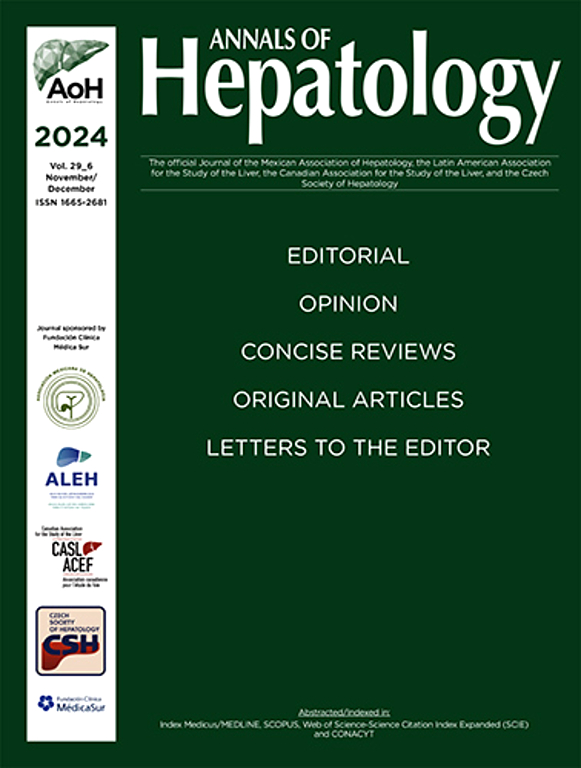Peripheral cellular immune alterations during excessive alcohol consumption
IF 3.7
3区 医学
Q2 GASTROENTEROLOGY & HEPATOLOGY
引用次数: 0
Abstract
Introduction and Objectives
The mechanisms that participate in the pathophysiology of chronic alcohol consumption and Alcoholic Liver Disease (ALD) include alterations of the innate and adaptive immune system, until now there is little information about the damage inducing mechanisms and their participation in the development of the disease. The objective was to determine the imbalance of peripheral cellular immunity according to the pattern of alcohol consumption.
Materials and Patients
Cross-sectional study included 5 groups of subjects with different patterns of alcohol consumption using AUDIT and DSM-IV. G1: Control with OH consumption<10g/day (CT); G2: Risk (Ri) and G3: Abuse (A) with AUDIT>8; G4: Alcoholism, without clinical or biochemical stigmata of damage (OH); G5: Patients with alcoholic liver cirrhosis (CiOH). T cells, T-CD4+, T-CD8+, B cells, NK and NKT were determined in peripheral blood by flow cytometry. For statistical analysis we performed U-Mann Whitney, considering p<0.05 significant.
Results
In the study, 589 subjects were included, average age 32±11, 30±11, 23±3, 31.5±13 and 47.5±7.7 years CT, Ri, A, OH y CiOH respectively (p<0.001). Alcohol consumption (g/day) was higher in OH 158(210,107), and CiOH 293(340,246) (p<0.001,both). Cellular determination of NK we found elevated (15.4 and 13.3vs11.1) and NKT (3.7 and 2.5vs1.7) in groups A, OH and CiOH (p<0.001), (p<0.001), (p<0.05) only in NK, during CiOH NKT decrease (1.4vs1.7)(p<0.001). In T cells we observed a decrease in OH (62.3vs66.5) and CiOH (56.8vs66.5) (p<0.001), the percentage of CD4+ cells decreased from the Ri group (35.7vs38.8)(p<0.01) until OH (35.1vs38.8)(p<0.01) while during CiOH they increase (41.8vs35.1)(p<0.05). CD8+ cells increase during OH (24.5vs21.1)(p<0.05) and decrease in CiOH (13.9vs21.1)(p<0.001) respectively.
Conclusions
The immune abnormalities presented during risky consumption, abuse, dependence and cirrhosis due to alcohol are differential, the most significant changes are observed in the cytotoxic NK, NKT and CD8+ and regulatory CD4+ populations generating a cellular imbalance that could be related to development and progression of liver damage.
过量饮酒时外周细胞免疫改变
慢性酒精摄入和酒精性肝病(ALD)的病理生理机制包括先天和适应性免疫系统的改变,迄今为止,关于其损伤诱导机制及其参与疾病发展的信息很少。目的是根据饮酒模式确定外周细胞免疫的不平衡。材料与患者横断面研究采用AUDIT和DSM-IV对5组具有不同酒精消费模式的受试者进行研究。G1:以OH摄取量10g/天(CT)为对照;G2:风险(Ri)和G3:滥用(A)审计>8;G4:酒精中毒,无临床或生化损伤印记(OH);G5:酒精性肝硬化(CiOH)患者。流式细胞术检测外周血T细胞、T- cd4 +、T- cd8 +、B细胞、NK和NKT。对于统计分析,我们采用U-Mann Whitney,认为p<;0.05具有显著性。结果共纳入589例受试者,平均年龄分别为32±11岁、30±11岁、23±3岁、31.5±13岁、47.5±7.7岁,CT、Ri、A、OH、CiOH年龄差异有统计学意义(p < 0.001)。OH 158(210,107)和CiOH 293(340,246)的酒精消费量(g/天)较高(p < 0.001)。细胞检测发现,在A组中NK (15.4 vs11.1)和NKT (3.7 vs2.5 vs1.7)升高,OH和CiOH组(p<0.001), (p<0.001),仅NK组(p<0.05), CiOH期间NKT降低(1.4vs1.7)(p<0.001)。在T细胞中,我们观察到OH (62.3vs66.5)和CiOH (56.8vs66.5)下降(p<0.001), CD4+细胞百分比从Ri组(35.7vs38.8)(p<0.01)下降到OH (35.1vs38.8)(p<0.01),而CiOH期间CD4+细胞百分比增加(41.8vs35.1)(p<0.05)。OH时CD8+细胞增加(24.5vs21.1)(p<0.05), CiOH时CD8+细胞减少(13.9vs21.1)(p<0.001)。结论危险消费、滥用、依赖和肝硬化期间出现的免疫异常是有区别的,细胞毒性NK、NKT和CD8+以及调节性CD4+群体的变化最为显著,导致细胞失衡,可能与肝损伤的发生和进展有关。
本文章由计算机程序翻译,如有差异,请以英文原文为准。
求助全文
约1分钟内获得全文
求助全文
来源期刊

Annals of hepatology
医学-胃肠肝病学
CiteScore
7.90
自引率
2.60%
发文量
183
审稿时长
4-8 weeks
期刊介绍:
Annals of Hepatology publishes original research on the biology and diseases of the liver in both humans and experimental models. Contributions may be submitted as regular articles. The journal also publishes concise reviews of both basic and clinical topics.
 求助内容:
求助内容: 应助结果提醒方式:
应助结果提醒方式:


